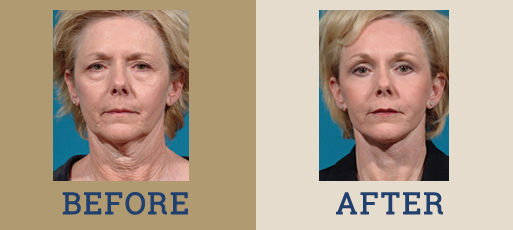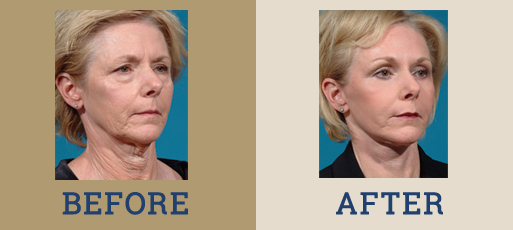Definition and Anatomy
Cosmetic surgery of the facial and neck soft tissues (skin, fat, and muscle) can provide dramatic rejuvenation. Most people know these procedures as “facelifts” or “necklifts.” Unlike the bones of the face, soft tissues are subject to the forces of gravity with age and to external influences such as the environment (sun) and smoking. With time, facial fat also undergoes “deflation” or involution. These contribute to the descent of the facial skin/fat/muscle as well as wrinkling. Fine wrinkles are often the result of excessive sun exposure; deeper wrinkles are caused by the intermittent contraction of facial muscles causing deep “grooves.” Progressive fat atrophy with age is also a factor in wrinkle formation and loss of facial “fullness.”
Goals
The goals of face and neck lifting are to re-suspend the soft tissues and to remove “excess” skin. In particular, features such as jowls, sagging cheek folds, sagging or “fat” neck, depressed corners of the mouth, and descent of cheek fat are amenable to surgical correction.
Surgical Procedure
The surgery itself is performed through well-hidden incisions in front of the ear and extending behind it into the hairline. Sometimes an additional incision is required just beneath the chin. The face and neck have several layers including the skin, fat, fascia (a strong layer of tissue covering the muscles), and muscle. Dr. Ha’s technique involves deep plane suspension (or SMAS facelift) – “tightening” of the fascia and/or skin, re-contouring the fat layer, and tightening the neck muscles. Previous notions of cutting out large amounts of excess skin has been supplanted by the newer concept of re-suspension, re-contouring, and preserving precious fat and skin. Dr. Ha believes that SMAS resuspension techniques have improved the longevity of face/neck lifting as well as providing more natural-appearing results. Also, he understands that deflation and loss of fat is a key component of facial aging; he focuses also on restoring facial volume through fat grafting or placement of implants in key areas.
Probably the most important concept is the one of “balance.” The lower face and neck does not age independently from the upper face/brow or eyelids. Often times the best result is obtained when complete facial rejuvenation is performed; this doesn’t necessarily mean that all procedures should be performed at the same time (surgeries can be separated), but consideration must be given to improving all areas of the face (upper and lower) and neck to provide the proper “balance.” Face and neck lifts are usually performed concurrently because of the inter-dependence of these two areas. However, the upper face (eyelids and brow) can be more reasonably addressed separately.
Recovery
Face/neck-lifting takes approximately 4 hours and is performed under general anesthesia for optimal patient comfort and for reduction of intra-operative bleeding. Recovery involves a variable period (3 to 6 weeks) of swelling, potential bruising, and incision care. The consequences of smoking are devastating to wound healing. It is critical to stop any nicotine products 3-4 weeks prior to and 6 weeks after surgery; failure to do so may result in skin necrosis and permanent scarring or deformity.
But, with proper pre and post-operative care and treatment, face/neck lifting can be a wonderful solution for progressive signs of aging by providing dramatic improvements in facial and neck contour.



